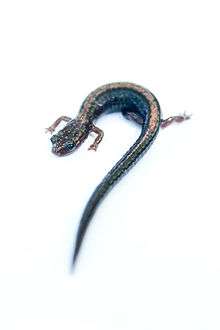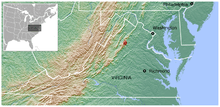Shenandoah salamander
| Shenandoah salamander | |
|---|---|
 | |
| Scientific classification | |
| Kingdom: | Animalia |
| Phylum: | Chordata |
| Class: | Amphibia |
| Order: | Urodela |
| Family: | Plethodontidae |
| Subfamily: | Plethodontinae |
| Genus: | Plethodon |
| Species: | P. shenandoah |
| Binomial name | |
| Plethodon shenandoah Highton and Worthington, 1967 | |
 | |
| Shenandoah salamander range (red)[1][2] | |
| Synonyms[3] | |
|
Plethodon richmondi shenandoah Highton and Worthington, 1967[4] | |
The Shenandoah salamander (Plethodon shenandoah) is a species of salamander in the family Plethodontidae. It is endemic to the United States and the state of Virginia.[1][3] It is only known from North facing talus slopes on three mountain tops inside the Shenandoah National Park.[1]
Description
Typical total length is 7.5–11 cm (3.0–4.3 in). There are two color phases, striped and unstriped. The unstriped phase is uniformly dark, while the striped phase has a narrow red stripe down the back. The unstriped phase may have reduced brassy pigmentation dorsally. The sides and the belly are black, but there are white spots and the belly has variable amounts of white or yellow mottling.[5]
Reproduction
Males and females typically establish separate feeding and/or mating territories underneath rocks and logs. Breeding occurs in fall and spring, with females attending clutches of eggs laid in crevices between rocks in their talus habitat.[6]
Habitat
The Shenandoah salamander occurs in steep, northerly facing talus slopes in forested situations, generally 800 m (2,600 ft) above sea level. It tolerates relative dry conditions. It appears to be excluded from moister habitats by competition with the more aggressive and competitively superior eastern red-backed salamander (Plethodon cinereus).[1][7]
Conservation
The Shenandoah salamander's range is entirely protected by the Shenandoah National Park, so habitat loss is unlikely to be a major threat, but the FWS identifies 1) defoliation of trees by gypsy moth, 2) its extremely restricted range size, and 3) competition with redbacked salamanders as reasons for its 1989 endangered listing under the Endangered Species Act.[8] Subsequent to this listing, climate change and the deadly amphibian pathogen Batrachochytrium dendrobatidis have been suggested as possible threats to highly restricted mountain-dwelling Appalachian salamanders.[9]
| Wikimedia Commons has media related to Plethodon shenandoah. |
References
- 1 2 3 4 5 Hammerson, G. & Mitchell, J. (2004). "Plethodon shenandoah". IUCN Red List of Threatened Species. IUCN. 2004: e.T17629A7210465. doi:10.2305/IUCN.UK.2004.RLTS.T17629A7210465.en. Retrieved 26 September 2017.
- ↑ National Geophysical Data Center, 1999. Global Land One-kilometer Base Elevation (GLOBE) v.1. Hastings, D. and P.K. Dunbar. National Geophysical Data Center, NOAA. doi:10.7289/V52R3PMS [access date: 2015-03-16].
- 1 2 Frost, Darrel R. (2017). "Plethodon shenandoah Highton and Worthington, 1967". Amphibian Species of the World: an Online Reference. Version 6.0. American Museum of Natural History. Retrieved 26 September 2017.
- ↑ Highton, Richard; Worthington, Richard D. (1967). "A new salamander of the genus Plethodon from Virginia". Copeia. 1967 (3): 617–626. doi:10.2307/1442241. JSTOR 1442241.
- ↑ "Shenandoah Salamander Plethodon shenandoah". Virginia Herpetological Society. Retrieved 26 September 2017.
- ↑ Dan Stone (2009). "Saving Salamanders in Shenandoah".
- ↑ "Plethodon shenandoah Shenandoah Salamander". AmphibiaWeb. University of California, Berkeley. 2017. Retrieved 26 September 2017.
- ↑ Anon (August 18, 1989). "Endangered and Threatened Wildlife and Plants; Determination of Threatened Status for the Cheat Mountain Salamander and Endangered Status for the Shenandoah Salamander" (PDF). Federal Register. 54 (159).
- ↑ Gratwicke, B., ed. (2008). Proceedings of the Appalachian Salamander Conservation Workshop. Apple Valley, MN: IUCN/SSC Conservation Breeding Specialist Group.
